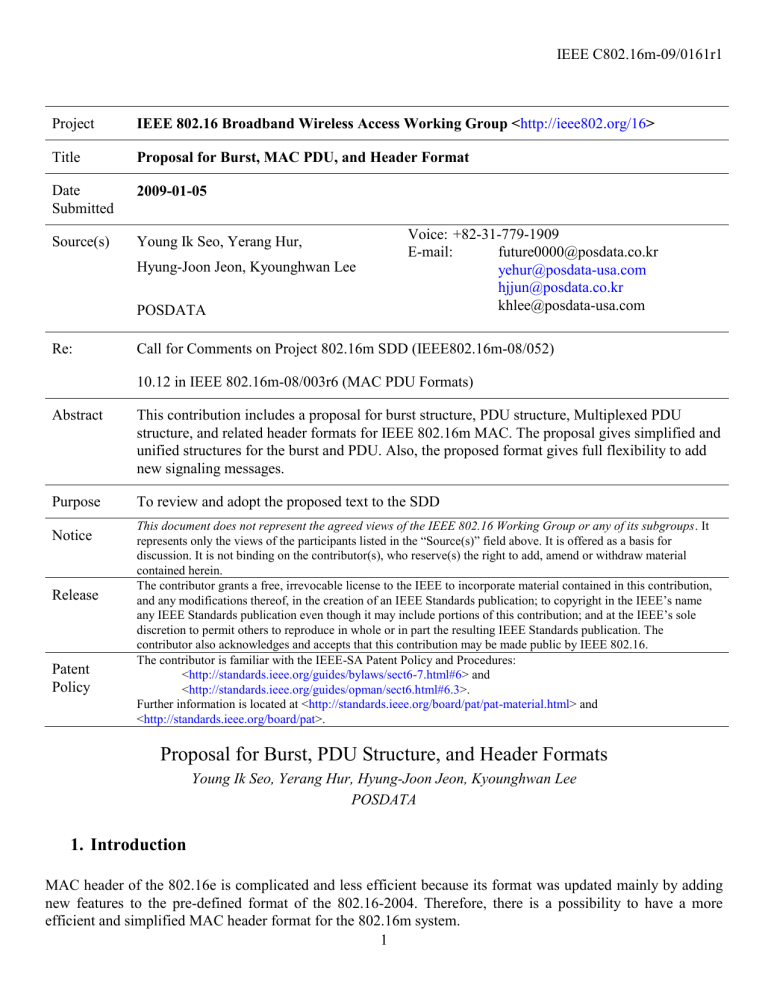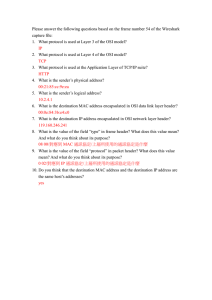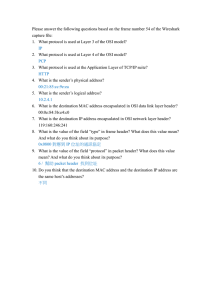IEEE C802.16m-09/0161r1 Project Title

IEEE C802.16m-09/0161r1
Project IEEE 802.16 Broadband Wireless Access Working Group < http://ieee802.org/16 >
Title Proposal for Burst, MAC PDU, and Header Format
Date
Submitted
2009-01-05
Source(s)
Re:
Young Ik Seo, Yerang Hur,
Hyung-Joon Jeon, Kyounghwan Lee
POSDATA
Voice: +82-31-779-1909
E-mail: future0000@posdata.co.kr
yehur@posdata-usa.com
hjjun@posdata.co.kr
khlee@posdata-usa.com
Call for Comments on Project 802.16m SDD (IEEE802.16m-08/052)
10.12 in IEEE 802.16m-08/003r6 (MAC PDU Formats)
Abstract
Purpose
Notice
Release
Patent
Policy
This contribution includes a proposal for burst structure, PDU structure, Multiplexed PDU structure, and related header formats for IEEE 802.16m MAC. The proposal gives simplified and unified structures for the burst and PDU. Also, the proposed format gives full flexibility to add new signaling messages.
To review and adopt the proposed text to the SDD
This document does not represent the agreed views of the IEEE 802.16 Working Group or any of its subgroups . It represents only the views of the participants listed in the “Source(s)” field above. It is offered as a basis for discussion. It is not binding on the contributor(s), who reserve(s) the right to add, amend or withdraw material contained herein.
The contributor grants a free, irrevocable license to the IEEE to incorporate material contained in this contribution, and any modifications thereof, in the creation of an IEEE Standards publication; to copyright in the IEEE’s name any IEEE Standards publication even though it may include portions of this contribution; and at the IEEE’s sole discretion to permit others to reproduce in whole or in part the resulting IEEE Standards publication. The contributor also acknowledges and accepts that this contribution may be made public by IEEE 802.16.
The contributor is familiar with the IEEE-SA Patent Policy and Procedures:
< http://standards.ieee.org/guides/bylaws/sect6-7.html#6 > and
< http://standards.ieee.org/guides/opman/sect6.html#6.3
>.
Further information is located at < http://standards.ieee.org/board/pat/pat-material.html
> and
< http://standards.ieee.org/board/pat >.
Proposal for Burst, PDU Structure, and Header Formats
Young Ik Seo, Yerang Hur, Hyung-Joon Jeon, Kyounghwan Lee
POSDATA
1.
Introduction
MAC header of the 802.16e is complicated and less efficient because its format was updated mainly by adding new features to the pre-defined format of the 802.16-2004. Therefore, there is a possibility to have a more efficient and simplified MAC header format for the 802.16m system.
1
The purpose of this proposal is as follows:
Make simplified and transparent format for MAC PDUs
Make the number of MAC header formats as small as possible
Reduce overhead on PDUs and bursts
IEEE C802.16m-09/0161r1
2.
Design Considerations
2.1
Burst Identification
In legacy systems, when MS receives the data it checks whether the MAC PDU in the burst is for itself by verifying the CID in the MAC PDU header, however, in 802.16m system, the MAC PDU header has only flow identifier and there is no information about its destination. To solve this problem, we introduce ‘subburst’ concept for the burst. In other words, the burst is divided into several subbursts and each subburst is equal to unicast burst. In this proposal, one of the following mechanisms is assumed to be implemented, to notify the destination and the size of each subburst.
The USCCH has the information on Station ID and the size for each subburst one by one, whose order follows the order of subburst in the burst. This is similar to the HARQ DL MAP IE in the 802.16e system.
The USCCH has the information on Station ID for each subburst one by one, whose order follows the order of subburst in the burst. In addition, the burst header has the information on the size for each subburst one by one, whose order is accorded with the order of subburst in the burst.
In any of the two methods, the size of subburst is known to the destination MS.
2.2
Length Field in GMH
The harmonized SDD for headers (C80216m-08_1410r3) defines GMH has the Length field to give the size of the MAC PDU. However, the length of the MAC PDU can be known if the size of subburst is known. Therefore, the information in the length field of GMH may be removed if we adopt the subburst concept for transmission.
Instead for packing and fragmentation, Packing subheader and Fragmentation subheader need the Length field, however, those two subheader format can be merged into one.
2.3
Minimize the Number of MAC Header Types
Increasing the number of MAC header types makes complicate the PDU processing at the receiver and needs more bits, for example HT field in GMH is used to differentiate the MAC header types. Therefore, it is important to minimize the number of MAC header types. The harmonized SDD for headers (C80216m-
08_1410r3) shows five types of MAC headers including Generic MAC Header (GMH), Compact Header,
Multicast/Broadcast MAC Header, Signaling MAC Header, and Extended Header. There may be also subheaders including fragmentation subheader and packing subheader. Among these, Multicast/Broadcast MAC
Header can be differentiated by its Station ID, Compact Header is not required if the current GMH is reduced further, Signaling MAC Header can be merged with Extended Header because of its similar characteristics and
2
IEEE C802.16m-09/0161r1 these two headers can be implemented using subheaders because of its small size. Then, only GMH format is required.
2.4
MAC Signaling Header Type I, II and Extended Subheader in Legacy System
All the signaling header type and extended subheader defined in the 802.16e system can be merged into one signaling subheader and several signaling information may be transmitted using the same PDU. This unified approach is beneficial to easily add new formats of signaling information in future.
2.5
Compact Type Payload subheader
In case of small size SDUs, e.g. VoIP packet, it is more important to reduce the header overhead. To meet this requirement, Compact Payload subheader (CPSH) is proposed whose size is just one byte. To make the size of
CPSH one byte, the length field becomes 6 bits, however, the 6bit length may not be sufficient in some cases.
To solve this problem, we add concept of basis length value (BLV). Section 4 describes the details of BLV.
3.
Proposed Burst Format
Based on the above consideration, following burst format is proposed. The burst consists of the optional Burst
Header field and several subbursts. The Burst Header field contains the length of each subburst whose unit may be Logical Resource Unit (LRU), however, the Burst Header field may be removed if the USCCH contains the length information of each subburst. Each subburst contains one or multiple PDUs with padding and CRC. That is, CRC is attached per subburst for further reducing the overhead.
Allocated burst size designated by USCCH
Allocated subburst size designated by USCCH or
Burst Header field
Subburst #1
Additional Subbursts
(Optional)
MAC PDU #1
Additional MAC PDUs
(Optional)
Signaling Subheaders
(Optional)
Payload
(Optional)
Figure 1 Burst Format
3
IEEE C802.16m-09/0161r1
Length of first subburst
-----
Length of last subburst
[HCS]
Figure 2 Burst Header Format (optional)
Length of subburst: This field indicates the length of each subburst. The unit is the size of logical resource unit.
HCS: Header Check Sequence.
4.
Proposed MAC Header Format
Based on the above consideration, we propose Generic MAC header with two types of subheaders: Signaling subheader and Payload subheader.
Generic MAC Header (GMH)
SHI PHI FlowID [EKS]
Figure 3 Generic MAC Header Format
SHI (Signaling Subheader Indicator): When set to ‘1’, this field indicates that one or more signaling subheader (SSH) is present following GMH.
PHI (Payload Subheader Indicator): When set to ‘1’, this field indicates that one or more payload subheader (PSH) is present following GMH or SSH.
If both of the SHI and PHI fields are set to ‘0’, it indicates that there is no more MAC PDUs in the subburst. That is, it can be used to indicate the start of padding.
FlowID (Flow Identifier): This field indicates the flow that is addressed. This field is 4 bits long.
[EKS]: Encryption Key Sequence.
Signaling Subheader (SSH)
4
IEEE C802.16m-09/0161r1
Last Type (5)
Body
Contents
Body Contents
Figure 4 Signaling Subheader Format
Last: When the “Last” bit is ‘0’, another signaling subheader will follow the current signaling subheader.
If this bit is ‘1’, this signaling subheader is the last.
Type: Type of Signaling subheader (SSH).
Body Contents: Type-dependent contents.
Payload Subheader (PSH)
Two types of PSH are proposed. One is compact payload subheader (CPSH) which is for the time critical flow whose packet length is relatively short. ARQ and fragmentation should be disabled because of its time critical characteristics and short length. The other is normal payload subheader (NPSH). NPSH can be used any kinds of flows except for the time critical flow.
Last PHT Length(6)
Figure 5 Compact Payload Subheader Format
Last PHT FC(2) BSN(4)
BSN(5) Length(3)
Length(8)
Figure 6 Normal Payload Subheader Format
Last: When the “Last” bit is ‘0’, another payload subheader will follow the current payload subheader plus payload. If this bit is ‘1’, this payload subheader is the last one.
PHT: Payload subheader type
0 = Compact Payload subheader
1 = Normal Payload subheader
FC: Indicates the fragmentation state of the payload
5
IEEE C802.16m-09/0161r1
00 = no fragmentation
01 = last fragment
10 = first fragment
11 = continuing (middle) fragment
BSN: Sequence number of the current ARQ block or the current SDU fragment
Length: Length of the current payload subheader plus payload in bytes. In case of CPSH, the length of
CPCH plus payload becomes the ‘Basis Length Value (BLV)’ plus the value in the length field where the
BLV can be defined using one of following methods:
Level 4: The BLV can be set using ‘BLV SSH’ for each PDU. This BLV is applied to all the
CPSHs in the current MAC PDU.
Level 3: The BLV can be set at USCCH for each burst. This BLV is applied to all the CPSHs in the burst designated by USCCH.
Level 2: The BLV can be set for a service flow. This BLV is applied to all the CPSHs for the service flow.
Level 1: The BLV can be set using broadcast channel (BCH) for the entire CPSHs in the system.
Level 0: Default value of the BLV is 0.
The priority of applying the BLV setting is from Level 4 to Level 0 from the highest priority to the lowest priority.
5.
Example of SSH
The MAC Signaling header types I, II and extended subheaders can be merged to one 802.16m SSH.
Bandwidth Request SSH
Bandwidth request has two types. One is incremental, the other is aggregated. It can be differentiated with subtype field.
7 6 5 4 3 2 1 0
Last Subtype Type =00000
BR MSB
BR LSB
Subtype 01 = Incremental
10 = Aggregated
00 or 11 = Reserved
Figure 7 Bandwidth Request SSH
6
Report SSH
MS can send reports using Report SSH to indicate its status.
7 6 5 4 3 2
Last Type =00010
1 0
Subtype=00
UL TX Power
Figure 8 UL Tx Power Report SSH
Other SSH
7
Last
6 5 4
Type =0101
3
Basis length value LSB
2 1 0
BLV MSB
Figure 9 Basis Length Value SSH
IEEE C802.16m-09/0161r1
7
Last
6 5 4
Type =0110
3
StationID LSB
2 1 0
StationID
BR MSB
BR LSB
Figure 10 Contention Based BR SSH
6.
Example of MAC PDU and Burst
Based on the above consideration, we propose the following MAC PDU format, where SSH or PSH may exist or not. That is, each MAC PDU can contain signaling messages only, payloads only, or both of the signaling message and payloads.
7
----Payload
Figure 11 MAC PDU Format
-----
-----
Figure 12 MAC PDU with Signaling Message Only
IEEE C802.16m-09/0161r1
Payload
Payload ----Payload
Figure 13 MAC PDU with Payloads Only
----Payload ----Payload
Figure 14 MAC PDU with Signaling Messages and Payloads
Text Proposal
---------------------------------------------------------Start of the Text----------------------------------------------------------
10.12 MAC PDU and Burst Formats
8
MAC PDU and burst shall be of the form illustrated in Figure XX1.
IEEE C802.16m-09/0161r1
Each burst may have the optional burst header field followed by the first subburst. More subbursts may follow the first subburst. If present, burst header shall be of the form illustrated in Figure XX2.
Each subburst has one or more MAC PDUs. Padding and CRC may follow the concatenated MAC PDUs.
Each PDU begins with the generic MAC header (GMH). The header is followed by the signaling subheaders, payload or both of the signaling subheaders and payload. If present, the payload shall consist of one or more
Payload subheaders and one or more MAC SDUs and/or fragments thereof.
Allocated burst size designated by USCCH
Allocated subburst size designated by USCCH or
Burst Header field
Subburst #1
Additional Subbursts
(Optional)
MAC PDU #1
Additional MAC PDUs
(Optional)
Signaling Subheaders
(Optional)
Payload
(Optional)
Figure XX1 MAC PDU and Burst Formats
Length of first subburst
-----
Length of last subburst
[HCS]
Figure XX2 Burst Header Format
9
IEEE C802.16m-09/0161r1
Each MAC PDU contains a MAC header. The MAC PDU may contain payload.
The MAC PDU may contain one or more extended headers.
Multiple MAC SDUs and/or SDU fragments from different unicast flows belonging to the same AMS can be multiplexed into a single MAC PDU
10.12.1 MAC header formats
10.12.1.1 Generic MAC Header
[Replace Figure 22 as indicated:]
SHI PHI FlowID [EKS]
Figure 9 Generic MAC header format
HT (Header Type): Indicates the type of the header. This field is TBD bits long.
EH (Extended Header Presence Indicator): When set to ‘1”, this field indicates that an Extended Header is present following this GMH.
SHI (Signaling Subheader Indicator): When set to ‘1’, this field indicates that one or more Signaling subheader (SSH) follows the generic MAC header.
PHI (Payload Subheader Indicator): When set to ‘1’, this field indicates that one or more payload subheader (PSH) follows the generic MAC header or SSH. If both of the SHI and PHI fields are set to
‘0’, this indicates the start of padding.
FlowID (Flow Identifier): This field indicates the flow that is addressed. This field is 4 bits long.
[EKS (2bits): ] Encryption Key Sequence
Length: Length of the payload. This field is 11 bits long.
FPI: The inclusion of FPI in GMH is FFS
10.12.1.2 Compact Header
Compact header format is FFS.
1
0
10.12.1.3
10.12.1.4
Multicast/Broadcast MAC header
IEEE C802.16m-09/0161r1
Multiplexing MAC Header
10.12.1.5 Signaling MAC Header
Signaling header format is FFS.
10.12.2 Extended header MAC subheader formats
10.12.2.1
Signaling subheader (SSH)
The inclusion of extended header Signaling subheader is indicated by EH indicator Signaling subheader indicator (SHI) bit in MAC Header. The EH SSH
format is shown in Figure 10 and will be used unless specified
otherwise.
[Replace Figure 23 as indicated:]
Last Type (5)
Body
Contents
Body Contents
Figure 10 Extended Header Signaling Subheader Format
Last: When the “Last” bit is set 0 , another extended header Signaling subheader will follow the current extended header Signaling subheader . If this bit is not set 1 , this extended header Signaling subheader is the last one.
Type: indicates the type of extended header signaling subheader . The length is TBD 5 .
Body Contents: Type-dependent contents.
10.12.2.1 Fragmentation and packing extended header
Fragmentation and packing extended header format is FFS.
10.12.2.2
Payload subheader (PSH)
1
1
IEEE C802.16m-09/0161r1
The inclusion of Payload subheader is indicated by the Payload subheader indicator (PHI) bit in MAC Header.
The PSH format has two types. One is Compact type shown in Figure XX3, the other is Normal type described in Figure XX4.
Last PHT Length(6)
Figure XX3 Compact Payload Subheader (CPSH) Format
Last PHT FC(2) BSN(4)
BSN(5) Length(3)
Length(8)
Figure XX4 Normal Payload Subheader (NPSH) Format
Last: When the “Last” bit is ‘0’, another Payload subheader will follow the current Payload subheader plus payload. If this bit is ‘1’, this Payload subheader is the last one.
PHT: Payload subheader type
0 = Compact Payload subheader
1 = Normal Payload subheader
FC: Indicates the fragmentation state of the payload
00 = no fragmentation
01 = last fragment
10 = first fragment
11 = continuing (middle) fragment
BSN: Sequence number of the current ARQ block or the current SDU fragment
Length: Length of the current Payload subheader plus payload in bytes. In case of CPSH, the length of
CPCH plus payload becomes the ‘Basis Length Value (BLV)’ plus the value in the length field where the
BLV can be defined using one of following methods:
Level 4: The BLV can be set using ‘BLV SSH’ for each PDU. This BLV is applied to all the
CPSHs in the current MAC PDU.
Level 3: The BLV can be set at USCCH for each burst. This BLV is applied to all the CPSHs in the burst designated by USCCH.
Level 2: The BLV can be set for a service flow when the service flow is created. This BLV is applied to all the CPSHs for the service flow.
Level 1: The BLV can be set using broadcast channel (BCH) for the entire CPSHs in the system.
1
2
IEEE C802.16m-09/0161r1
Level 0: Default value of the BLV is 0.
The applying priority of the BLV setting is Level 4, Level 3, Level 2, Level 1 and Level 0 from the highest priority to the lowest priority.
---------------------------------------------------------End of the Text---------------------------------------------------------
1
3

